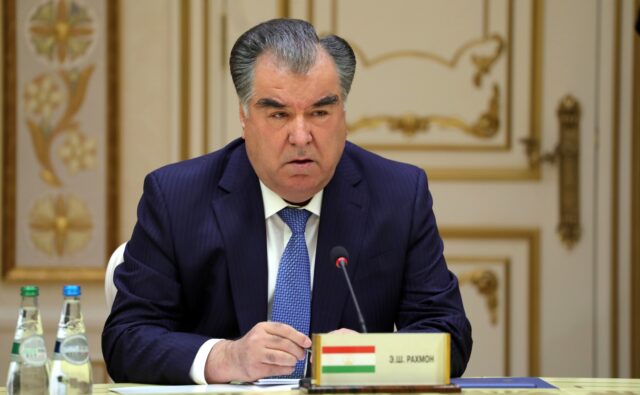
The recent meeting between Russian Foreign Minister Sergei Lavrov and Tajikistan’s President Emomali Rahmon has unveiled the Central Asian republic’s strategic role for Moscow’s foreign policy in the region in defence, security, economy and social sectors.
On June 6th, 2023, Russian Foreign Affairs Minister Sergei Lavrov concluded his trip to Tajikistan, after meeting with Tajik President Emomali Rahmon in closed-door negotiations. During his two-day visit, Lavrov delivered several statements addressing key areas of concern such as security, economic integration, migration and international cooperation.
Lavrov’s Visit Impact on Russia-Tajikistan Relations
Regarding safety, Lavrov highlighted the West’s growing inclination to undermine Russia and the potential risks posed by the United States in Central Asia. He emphasised the possibility of the US attempting to destabilise the region, particularly considering their withdrawal from Afghanistan in 2021. Notably, Tajikistan hosts the 201st Russian military base and is an important partner for Russia within the Collective Security Treaty Organization (CSTO).
In terms of trade and economic cooperation, Moscow looks forward to Tajikistan’s accession to the Eurasian Economic Union (EAEU) and expects Dushanbe to express its interest in further strengthening economic ties. Tajikistan, except for Turkmenistan, remains the sole Central Asian country with no status within the EAEU, while Uzbekistan has observer status since 2020.
Lavrov and Rahmon also discussed migration issues. Both parties are actively working to prevent conflicts involving labour migrants from Central Asia in Russia. The financial contributions from migrants are vital to the economic well-being of the region, as they constitute a significant portion of Tajikistan’s total GDP, accounting for one-third of the country’s income.
In terms of international cooperation, Lavrov urged the countries of Central Asia to exercise caution when considering cooperation programs proposed by Western countries. He expressed doubt about Washington’s genuine interest in promoting peace and stability in the region.
President Rahmon echoed these concerns at the recent Central Asia-EU summit, where he called for increased European assistance to fortify borders with Afghanistan.
Geopolitical Scenario Analysis
The recent meeting between Lavrov and Rahmon shed light on the Kremlin’s apprehensions regarding security and foreign interference in Central Asia, particularly from the United States. Given the region’s vital significance to Moscow’s foreign policy, characterised by the concepts of blizhnee zarubezhe (near abroad) and lebensraum (vital space) the Kremlin deems it crucial to prevent foreign actors from acquiring increased influence and activity in the region.
Lavrov’s emphasis on the potential destabilisation efforts by the US and the significance of Tajikistan as a CSTO partner drew attention on the need for heightened vigilance and proactive measures to mitigate these risks. It also hinted at Russia’s continued military presence in Tajikistan and the possibility of deepening defence and military cooperation with Dushanbe.
On one hand, Moscow’s expectations of Tajikistan’s future accession to the EAEU and the desire for enhanced economic cooperation present an opportunity for Tajikistan to consider the potential benefits and implications, fostering discussions on trade partnerships and economic integration with Russia and other member states.
On the other hand, Tajikistan’s EAEU membership would firmly place the country under the umbrella of Russian influence, potentially creating a distancing effect with the United States and the European Union. Additionally, such membership would solidify Moscow-Dushanbe relations and cooperation, potentially overshadowing Beijing’s significant investments in local infrastructure projects.
The growing influence of Russia in Tajikistan is also clear in the significant role played by Tajik labour migrants. Official data from the Main Directorate for Migration of the Ministry of Internal Affairs of the Russian Federation reveals that in 2021 alone, 768,727 Tajik citizens obtained documents for labour activity in Russia, contributing approximately $900 million to the Russian budget.
Furthermore, according to the Central Bank of Russia, money transfers from Russia to Tajikistan through payment systems amounted to $1,795 million, with 94% of this total transferred in rubles. These numbers speak volumes about the significance of Tajik labour migrants and their contribution to both the Russian and Tajik economies.
Collaborative efforts between Russia and Tajikistan have led to the legalisation of approximately 200,000 Tajik citizens’ stay in Russia over the past two years, with a ‘migration amnesty’ benefiting 120,490 Tajik citizens in August 2021.
These initiatives further show the Kremlin’s utilisation of labour migrants and Tajiks with Russian passports to strengthen ties between Tajikistan and Russia while countering Western interference.
Author: Giuliano Bifolchi
For further analyses, risk assessment, or geopolitical reports on Russia-Tajikistan relations and the Kremlin’s strategy in Central Asia, contact us at info@specialeurasia.com.



